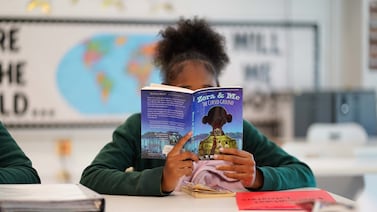To address persistent academic struggles, Adams 14 leaders have proposed developing community schools to provide extensive wraparound services such as tutoring for students, English classes for parents, on-site laundry facilities, and food pantries.
They hope a bill nearing final approval will make the State Board of Education more receptive to their plans. Senate Bill 54 would establish the community school model as an option for schools with turnaround status, the lowest rating in the state’s school performance system.
But the bill’s main Senate sponsor said her proposal was not designed for districts that have already faced state intervention. That would include Adams 14, which has been on a state watchlist for a decade and is fighting to maintain its autonomy after it ousted a state-ordered external manager.
“This is for the beginning of the end, not the end of the end, which is where Adams 14 is at,” said state Sen. Rachel Zenzinger, an Arvada Democrat.
Adams 14 school district serves the working-class Denver suburb of Commerce City. In 2018, after eight years of persistently low test scores, it became the first Colorado district that the state ordered to turn over day-to-day operations to an external management company. This year, under the leadership of Superintendent Karla Loria, the school board terminated its relationship with the company, MGT Consulting.
Adams 14 is scheduled for a hearing in front of the State Board of Education in April to determine next steps. The board has asked for feedback on the most drastic option available to it, dissolving and reorganizing the district.
The Adams 14 school board, meanwhile, says it wants the opportunity to chart its own course and has sued the state in an effort to change the terms of the accountability process. Loria has pushed back against the idea that students aren’t achieving enough. More than half of the district’s 5,700 students are learning English, yet many have to take standardized tests in English. And nearly 73% qualify for subsidized lunches, a measure of poverty.
“There are complicated reasons why schools end up in turnaround status,” Loria told the House Education Committee Wednesday. “It has to do with poverty, the way we test not being conducive to certain communities, our rating system, and the list could go on. The worst thing that can happen is for the state to close a school or take other adverse actions that disrupt the lives of our students and our school community.”
Loria called community schools a “wonderful option” for Adams 14 and welcomed a suggestion from state Rep. Cathy Kipp, a Fort Collins Democrat, to enable the bill to go into effect before the April hearing. But other committee members declined to do that, so the bill likely would go into effect some time this summer.
Also this week, the district’s school board adopted a resolution stating its intent to pursue the development of community schools, including at Central Elementary, which has been flagged for very low performance and could face state intervention beyond what’s aimed at the district.
Community schools require extensive engagement with parents and staff to identify programs that would provide more stability for students. Those could include adult education in English, literacy, and job skills, mentoring and tutoring, access to medical care, and more.
A 2019 bill allowed schools to pursue a community schools model as a form of innovation status, which grants schools exemptions from certain state rules. This year’s bill would add the community schools model to the options available for schools that face state intervention after five years of persistent low performance. The other options are innovation status, conversion to a charter school, closure, or external management.
Neither bill provides money for wraparound programs, but community schools can pursue grants.
The bill passed the Senate with broad bipartisan support. It moved out of the House Education Committee on a partyline vote after Republicans said they were concerned about anti-charter comments made by Adams 14 representatives.
Zenzinger said community schools might have been a good option for Adams 14 in 2018, but now it may be too late. Regardless of the merits, she didn’t draft the bill to present the district with another option.
“The secret sauce about community schools is you really need to be committed to it and it needs to be from within,” Zenzinger said. “I understand the advocates are really excited about this, but it’s become very political. I think they are taking the concept of community schools and plopping them down on their side of the argument.”
Without explicit legislative authority, it’s hard to say how the State Board would respond to a request from Adams 14 to develop community schools, a spokesperson said.
Zenzinger said the crisis in Adams 14 does call out for further legislative action.
“We are unprepared as a state for a school district reaching this point,” she said. “There isn’t anything outlined in our accountability system to say what happens now.”
Bureau Chief Erica Meltzer covers education policy and politics and oversees Chalkbeat Colorado’s education coverage. Contact Erica at emeltzer@chalkbeat.org.







